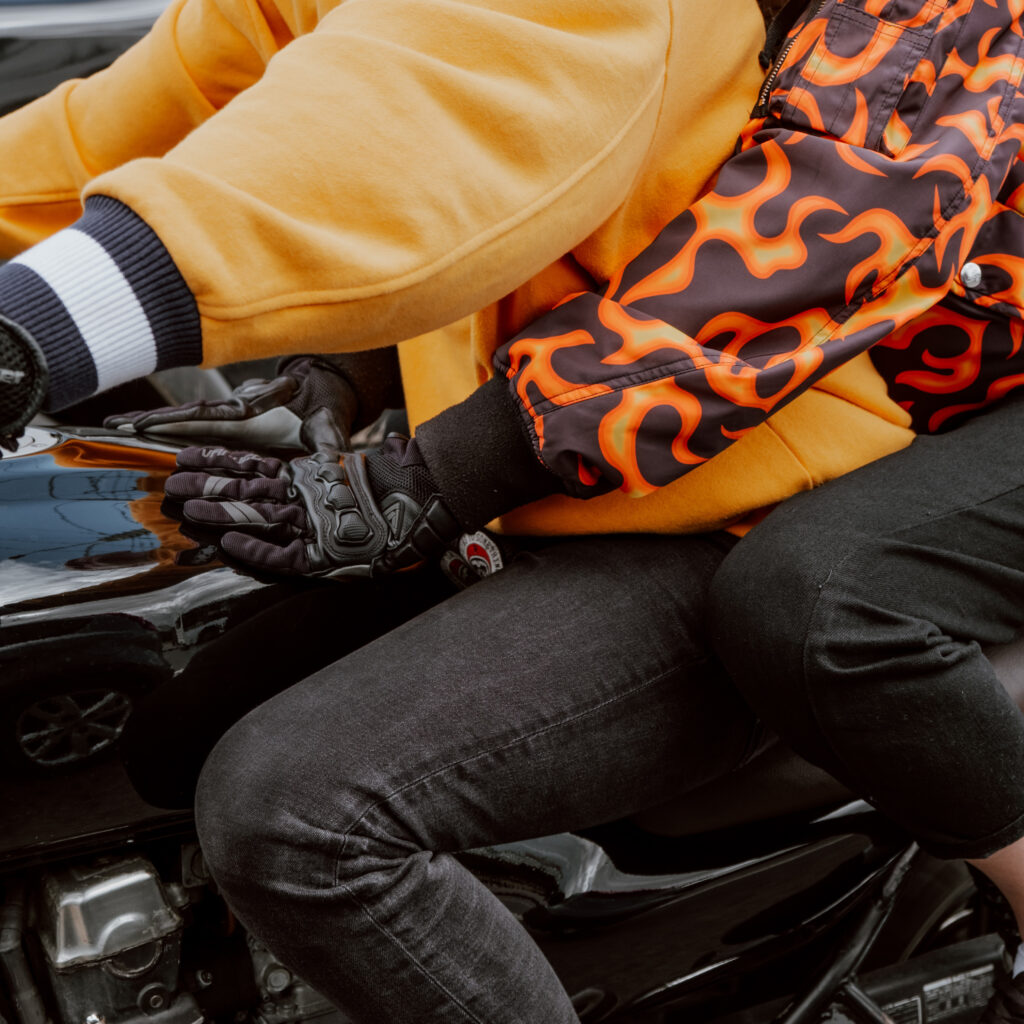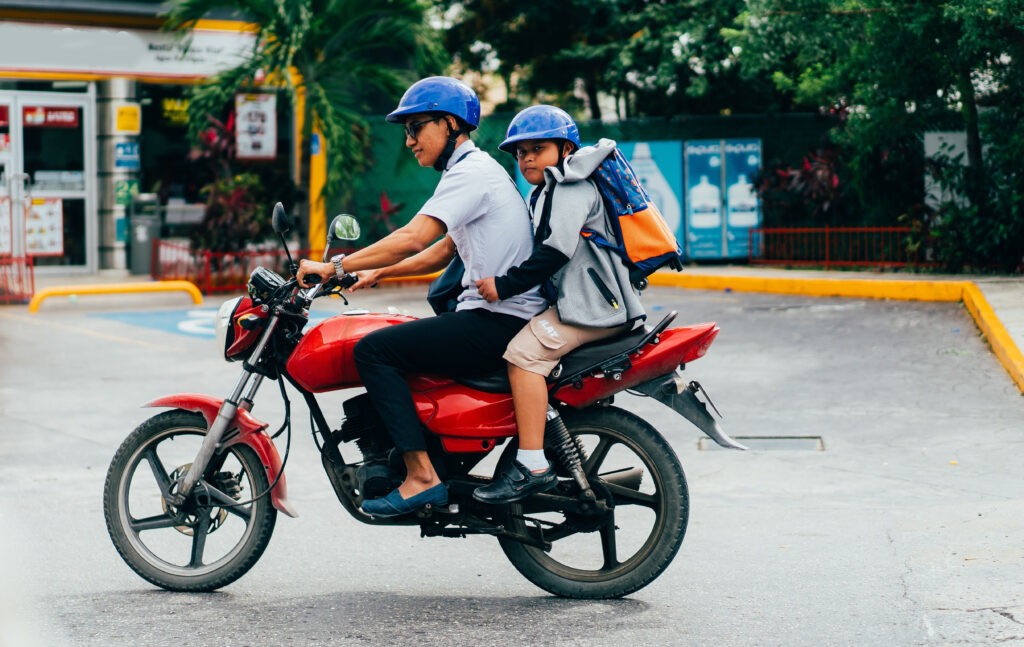The first thing a rider needs to understand before carrying a passenger is the doubled responsibility. You are no longer riding a bike alone, and the safety of both yourself and your passenger depends on your driving skills. Let’s explore the nuances of riding a motorcycle with a passenger with motorcycle trainer Kevin Williams.
Give instructions to the passenger
- The passenger’s feet should be placed on the footpegs, which are usually located just behind the rider’s footpegs. These footpegs are designed for the passenger’s comfort and safety. It’s essential for the rider to remember to lower the footpegs when passenger getting on the motorcycle, ensuring their feet are securely positioned during the ride.
- The passenger should know how to hold on to the rider for stability. If there are special handrails or handles, beginners should hold onto them for added support and safety. Some motorcycles come equipped with passenger handrails or rider grips, which are belt-like devices with handles. Passengers can securely hold onto these handles to maintain balance and stability during the ride.
- During sudden braking, the passenger should prepare themselves by gripping the rider or handles firmly. It’s important to press the seat with their thighs to brace themselves and avoid falling forward onto the driver. This position helps distribute the force of the deceleration more evenly and ensures both rider and passenger stay securely in place.
- To enhance stability and reduce wind resistance, the passenger should sit as close to the rider as possible. This minimizes the air cushion between them, making the motorcycle more aerodynamic and easier to control. It also helps maintain better balance.
- It’s crucial for the passenger never to lean against the usual cases on the back of the bike. These cases are not designed to support a passenger’s weight or maintain balance. Only lean on special large cases that are part of the original motorcycle design, such as those on bikes like the Honda Gold Wing and large BMW Touring models. These cases are designed to accommodate passenger weight and are safe for leaning on during the ride. Using them for support can provide added comfort and stability.

How to Accelerate, Brake, and Maneuver
The most crucial rule is to perform every action with gentleness.
- Begin acceleration smoothly, and before doing so, inform your passenger that you’re starting your journey. It’s equally important to brake gently and well in advance.
- Keep in mind that there is now added weight on the bike, which affects its handling compared to when you’re riding alone. When using the rear brake, the motorcycle won’t dip as much as it would with a solo rider.
- In traffic congestion, avoid emulating cars by making abrupt movements. Move in a measured manner. Wait until the vehicle in front has created a sufficient gap, then proceed and stop. Remember that when maneuvering between lanes with a passenger, the motorcycle may become less stable.
- When coming to a stop, ensure the motorcycle and your passenger are upright.
- Pay attention to where you place your feet; this is essential because you’re controlling more weight than usual. Verify that there are no potholes, slippery spots, or oil spills beneath your feet.
Negotiating Various Obstacles
- The rider should promptly spot all road obstacles (such as bumps, holes, etc.) that they’d prefer to avoid.
- If avoiding an obstacle isn’t possible, gradually reduce your speed and refrain from using the front brake. The simplest approach is to slow down and then gently ease off the throttle.
- Speed bumps should be crossed directly, with the motorcycle perpendicular to the road.
- Shiny spots on the road pose a potential hazard, so it’s best to avoid them.
Passenger Weight
- Larger motorcycles (e.g., BMW Tourer) tend to be less affected by the added weight, making them more manageable when carrying a passenger.
- Riding with a lighter passenger is generally easier.
- The passenger’s weight should be compensated for by adjusting the rear shock absorbers to create firmer spring compression.
- Prior to riding with a passenger, check the chain tension. If it is too tight, it should be loosened.
Five Prohibitions for a Passenger While Riding
- Children: Avoid taking risks when transporting children. The child should be at least 12 years old or taller than 145 cm, and they must use specialized seat belts designed for securing them, in addition to wearing a helmet.
- Sobriety: The passenger should be sober during the ride.
- Protective Equipment: The passenger must wear appropriate protective gear, including a jacket, trousers, boots, gloves, and a helmet. Loose or flapping clothing that could get caught in the chain should be avoided.
- Movement: The passenger should refrain from moving while the motorcycle is decelerating or coming to a stop.
- Distractions: The passenger should not engage in conversation or otherwise distract the rider while the motorcycle is in motion.

Five Mandatory Rules for a Rider When Carrying a Passenger
- Motorcycle Design: Ensure that your motorcycle is specifically designed to accommodate a passenger, complete with footrests and a suitable passenger seat.
- Sobriety: Both the rider and passenger should be sober during the journey.
- Passenger’s Equipment: Confirm that the passenger is equipped with all the necessary safety gear.
- Passenger Instructions: Inform the passenger about what to expect during the ride. Explain how and where to hold on, the proper foot placement, and how to behave during maneuvers. Additionally, emphasize that the passenger should mount and dismount the bike only after the rider.
- Smooth Riding: Prioritize gentle acceleration and braking. This not only enhances the passenger’s comfort but also aids in maintaining better control of the motorcycle.
When Can You Start Riding with a Passenger?
- The rider’s level of driving skills should be appropriate. The rider must feel confident on various types of roads and under different weather conditions.
- Begin by gaining experience on easy roads, preferably on a dry, sunny day.
- On extended journeys with a passenger, keep in mind that passengers may tire more quickly than the rider.
Under What Circumstances Should a Passenger Not Ride with a Rider?
- Avoid riding a motorcycle with individuals you don’t know.
- Evaluate the motorcycle you plan to ride; the seat may be too small or uncomfortable for you.
- Never ride with a rider who is under the influence of alcohol or drugs.
Motorcycle trainer Kevin Williams suggests an exercise: Imagine you have an egg in a cup placed on the tank of your motorcycle. Your goal is to balance and maneuver in a way that prevents you from losing the egg while riding. This exercise emphasizes the need for smooth and controlled movements while carrying a passenger.
Watch the complete interview with Kevin Williams discussing the nuances of riding a motorcycle with a passenger on our YouTube channel.











